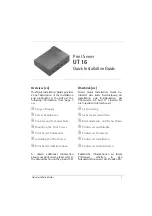
136
Glossary
The following table contains explanations of some of the terms used in this guide which may be unfamiliar or which are not explained in the text of the guide.
Further information can be obtained by referring to other commercially-available publications.
3-2 pull-down function
This function directly converts image sources that have been recorded in the same 24-frame format used for movies into 60-
frame progressive signals. This allows data such as DVD software that has been recorded in 24-frame format to be played
back on large screens with more natural and accurate reproduction, without any loss of image quality from the original movie.
5BNC
A port used to input analogue video signals.
Aspect ratio
The ratio between an image's length and its height. HDTV images have an aspect ratio of 16:9 and appear elongated. The
aspect ratio for standard images is 4:3.
Colour temperature
The temperature of an object which is emitting light. If the colour temperature is high, the colours tend to take on a bluish
tinge. If the colour temperature is lower, the colours tend to take on a reddish tinge.
Component video
Video signals which have the video brightness signals and colour signals separated, in order to provide better image quality. In
high-definition TV (HDTV), it refers to images which consist of three independent signals: Y (luminance signal), and Pb and
Pr (colour difference signals).
Composite video
Video signals which have the video brightness signals and colour signals mixed together. The type of signals commonly used
by household video equipment (NTSC, PAL and SECAM formats).
The carrier signal Y (luminance signal) and chroma (colour) signal which are contained in the colour bar are overlapped to
form a single signal.
Contrast
The relative brightness of the light and dark areas of an image can be increased or decreased in order to make text and
graphics stand out more clearly, or to make them appear softer. Adjusting this particular property of an image is called
"contrast adjustment".
Cool-down
This is the process by which the projector's lamp is cooled down after it has become hot through use. It is carried out
automatically when the [Power] button on either the remote control or the projector's control panel has been pressed to turn
the projector off. Do not disconnect the power cord while cool-down is in progress, otherwise the cool-down process will not
work properly. If the cool-down period is not allowed to finish normally, the projector's lamp and internal components will
remain at high temperatures, and this may shorten the operating life of the lamp or cause problems with the operation of the
projector.
DFP
Abbreviation for Digital Flat Panel. Refers to a standard method for digital transmission of video signals.
DHCP
Abbreviation for Dynamic Host Configuration protocol, which is a protocol for automatically assigning an
for
devices that are connected to a network.
Dolby Digital
A sound format developed by Dolby Laboratories. Normal stereo is a 2-channel format which uses two speakers. Dolby
Digital is a 6-channel (5.1-channel) system which adds to this a centre speaker two rear speakers and a sub-woofer.
DVI
(DVI-D)
Abbreviation for Digital Visual Interface. Refers to a standard method for digital transmission of video signals.
DVI is a standard which has also been applied to digital household electronic equipment other than computers. It allows
images to be transmitted at higher resolutions than for DFP, and also includes a digital signal encoding function.
Summary of Contents for EMP 7800
Page 1: ......















































